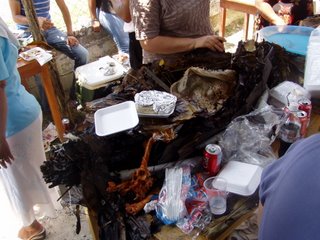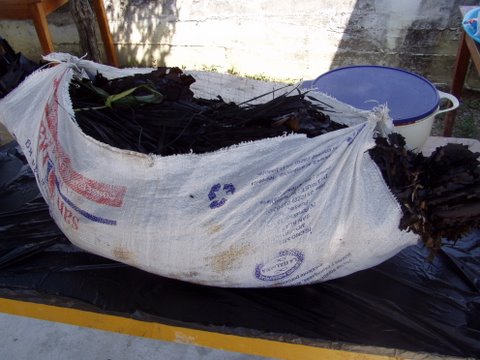In the Huasteca of Mexico I had the opportunity to partake of much local cuisine, from Potosian enchiladas at the hotel, to chopped up nopal (that is, prickly pear cactus) at a preacher’s home. As Mr. Dugan told me, This is real Mexican food!
Zacahuil
While in Mexico we attended the wedding of the son of a certain preacher, and after the ceremony they served all the guests a very singular dish dubbed zacahuil (sah-kah-WEEL). I think this is a Huastec food, but I could be wrong. At any rate, I was told that it resembles a gigantic tamale, and its method of cooking is quite fascinating.
 First they wrap the whole thing up in banana leaves (I do not know the ingredients myself), and they bury the whole thing. Above the buried zacahuil they build a fire, thus cooking the food below. Later on they dig it up and voilà! it’s ready to serve.
First they wrap the whole thing up in banana leaves (I do not know the ingredients myself), and they bury the whole thing. Above the buried zacahuil they build a fire, thus cooking the food below. Later on they dig it up and voilà! it’s ready to serve.
They had two such giant tamales there, and those two were sufficient to feed everybody (although they did offer us barbecue in the event that we didn’t like the native food). As mentioned, I still don’t know what they make zacahuil out of, but I liked it. At the wedding they peeled back the banana leaves, put the good stuff in a big bowl, and then dished it out for everybody. There were some large bones in the mixture that they took out, so perhaps an ungulate was sacrificed for the meal.
Mamey
 At El Cañón, we had a nice lunch of tortillas, rice, beans, and nopal, and afterwards there was a fruit called mamey (mah-MAY) for dessert. These fruits had a thick skin similar to a coconut, and were shaped like sweet potatoes. They each had a large black seed on the inside, but once this was removed the soft, semisweet orange flesh could be easily removed and eaten with a fork. I ate a fourth of one of these, and found it quite tasty.
At El Cañón, we had a nice lunch of tortillas, rice, beans, and nopal, and afterwards there was a fruit called mamey (mah-MAY) for dessert. These fruits had a thick skin similar to a coconut, and were shaped like sweet potatoes. They each had a large black seed on the inside, but once this was removed the soft, semisweet orange flesh could be easily removed and eaten with a fork. I ate a fourth of one of these, and found it quite tasty.
Hail to the cooks
At nearly every place we visited, the ladies had prepared us a meal, and for this I am very grateful. All the food was most delicious, and I really enjoyed getting a taste of San Luis Potosí. From chicken sandwiches to tamales, French fries to homemade tortillas, and (lest I forget) those delectable quesadillas, the Christian women of Mexico are not only great cooks, but are also so hospitable as to share it with us. Tlaskamati.
Note about the title: In case you have not read my previous post on the Huastec language, the phrase used in the title means “Let’s eat!”
